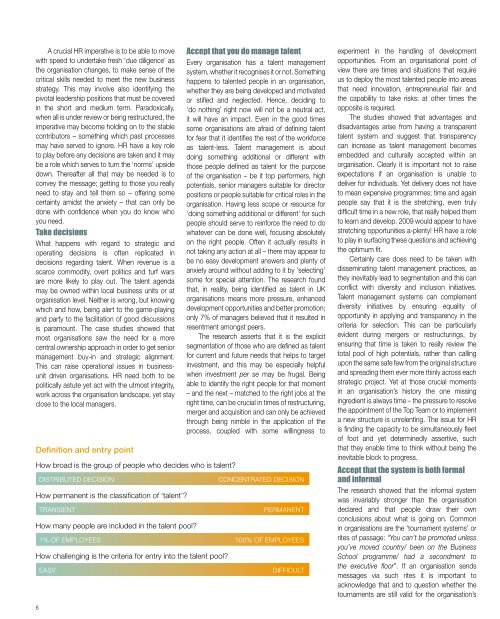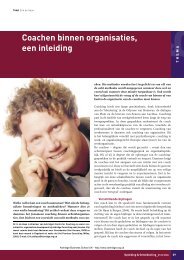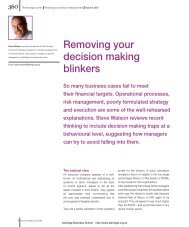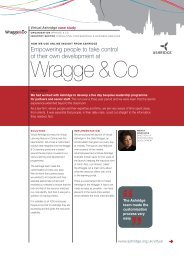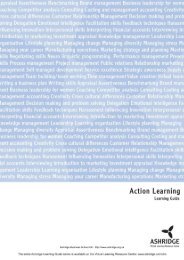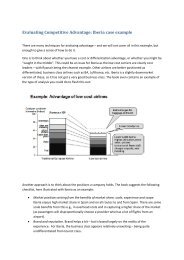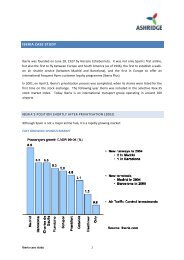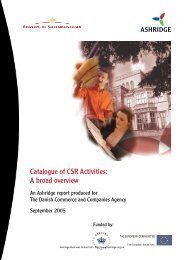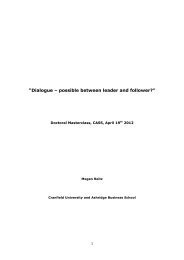Talent Management in the current climate Brewing up ... - Ashridge
Talent Management in the current climate Brewing up ... - Ashridge
Talent Management in the current climate Brewing up ... - Ashridge
You also want an ePaper? Increase the reach of your titles
YUMPU automatically turns print PDFs into web optimized ePapers that Google loves.
A crucial HR imperative is to be able to move<br />
with speed to undertake fresh ‘due diligence’ as<br />
<strong>the</strong> organisation changes, to make sense of <strong>the</strong><br />
critical skills needed to meet <strong>the</strong> new bus<strong>in</strong>ess<br />
strategy. This may <strong>in</strong>volve also identify<strong>in</strong>g <strong>the</strong><br />
pivotal leadership positions that must be covered<br />
<strong>in</strong> <strong>the</strong> short and medium term. Paradoxically,<br />
when all is under review or be<strong>in</strong>g restructured, <strong>the</strong><br />
imperative may become hold<strong>in</strong>g on to <strong>the</strong> stable<br />
contributors – someth<strong>in</strong>g which past processes<br />
may have served to ignore. HR have a key role<br />
to play before any decisions are taken and it may<br />
be a role which serves to turn <strong>the</strong> ‘norms’ <strong>up</strong>side<br />
down. Thereafter all that may be needed is to<br />
convey <strong>the</strong> message; gett<strong>in</strong>g to those you really<br />
need to stay and tell <strong>the</strong>m so – offer<strong>in</strong>g some<br />
certa<strong>in</strong>ty amidst <strong>the</strong> anxiety – that can only be<br />
done with confidence when you do know who<br />
you need.<br />
Take decisions<br />
What happens with regard to strategic and<br />
operat<strong>in</strong>g decisions is often replicated <strong>in</strong><br />
decisions regard<strong>in</strong>g talent. When revenue is a<br />
scarce commodity, overt politics and turf wars<br />
are more likely to play out. The talent agenda<br />
may be owned with<strong>in</strong> local bus<strong>in</strong>ess units or at<br />
organisation level. Nei<strong>the</strong>r is wrong, but know<strong>in</strong>g<br />
which and how, be<strong>in</strong>g alert to <strong>the</strong> game-play<strong>in</strong>g<br />
and party to <strong>the</strong> facilitation of good discussions<br />
is paramount. The case studies showed that<br />
most organisations saw <strong>the</strong> need for a more<br />
central ownership approach <strong>in</strong> order to get senior<br />
management buy-<strong>in</strong> and strategic alignment.<br />
This can raise operational issues <strong>in</strong> bus<strong>in</strong>essunit<br />
driven organisations. HR need both to be<br />
politically astute yet act with <strong>the</strong> utmost <strong>in</strong>tegrity,<br />
work across <strong>the</strong> organisation landscape, yet stay<br />
close to <strong>the</strong> local managers.<br />
Def<strong>in</strong>ition and entry po<strong>in</strong>t<br />
How broad is <strong>the</strong> gro<strong>up</strong> of people who decides who is talent?<br />
6<br />
Accept that you do manage talent<br />
Every organisation has a talent management<br />
system, whe<strong>the</strong>r it recognises it or not. Someth<strong>in</strong>g<br />
happens to talented people <strong>in</strong> an organisation,<br />
whe<strong>the</strong>r <strong>the</strong>y are be<strong>in</strong>g developed and motivated<br />
or stifled and neglected. Hence, decid<strong>in</strong>g to<br />
‘do noth<strong>in</strong>g’ right now will not be a neutral act,<br />
it will have an impact. Even <strong>in</strong> <strong>the</strong> good times<br />
some organisations are afraid of def<strong>in</strong><strong>in</strong>g talent<br />
for fear that it identifies <strong>the</strong> rest of <strong>the</strong> workforce<br />
as talent-less. <strong>Talent</strong> management is about<br />
do<strong>in</strong>g someth<strong>in</strong>g additional or different with<br />
those people def<strong>in</strong>ed as talent for <strong>the</strong> purpose<br />
of <strong>the</strong> organisation – be it top performers, high<br />
potentials, senior managers suitable for director<br />
positions or people suitable for critical roles <strong>in</strong> <strong>the</strong><br />
organisation. Hav<strong>in</strong>g less scope or resource for<br />
‘do<strong>in</strong>g someth<strong>in</strong>g additional or different’ for such<br />
people should serve to re<strong>in</strong>force <strong>the</strong> need to do<br />
whatever can be done well, focus<strong>in</strong>g absolutely<br />
on <strong>the</strong> right people. Often it actually results <strong>in</strong><br />
not tak<strong>in</strong>g any action at all – <strong>the</strong>re may appear to<br />
be no easy development answers and plenty of<br />
anxiety around without add<strong>in</strong>g to it by ‘select<strong>in</strong>g’<br />
some for special attention. The research found<br />
that, <strong>in</strong> reality, be<strong>in</strong>g identified as talent <strong>in</strong> UK<br />
organisations means more pressure, enhanced<br />
development opportunities and better promotion;<br />
only 7% of managers believed that it resulted <strong>in</strong><br />
resentment amongst peers.<br />
The research asserts that it is <strong>the</strong> explicit<br />
segmentation of those who are def<strong>in</strong>ed as talent<br />
for <strong>current</strong> and future needs that helps to target<br />
<strong>in</strong>vestment, and this may be especially helpful<br />
when <strong>in</strong>vestment per se may be frugal. Be<strong>in</strong>g<br />
able to identify <strong>the</strong> right people for that moment<br />
– and <strong>the</strong> next – matched to <strong>the</strong> right jobs at <strong>the</strong><br />
right time, can be crucial <strong>in</strong> times of restructur<strong>in</strong>g,<br />
merger and acquisition and can only be achieved<br />
through be<strong>in</strong>g nimble <strong>in</strong> <strong>the</strong> application of <strong>the</strong><br />
process, co<strong>up</strong>led with some will<strong>in</strong>gness to<br />
DISTRIBUTED DECISION CONCENTRATED DECISION<br />
How permanent is <strong>the</strong> classification of ‘talent’?<br />
TRANSIENT PERMANENT<br />
How many people are <strong>in</strong>cluded <strong>in</strong> <strong>the</strong> talent pool?<br />
1% OF EMPLOYEES 100% OF EMPLOYEES<br />
How challeng<strong>in</strong>g is <strong>the</strong> criteria for entry <strong>in</strong>to <strong>the</strong> talent pool?<br />
EASY DIFFICULT<br />
experiment <strong>in</strong> <strong>the</strong> handl<strong>in</strong>g of development<br />
opportunities. From an organisational po<strong>in</strong>t of<br />
view <strong>the</strong>re are times and situations that require<br />
us to deploy <strong>the</strong> most talented people <strong>in</strong>to areas<br />
that need <strong>in</strong>novation, entrepreneurial flair and<br />
<strong>the</strong> capability to take risks: at o<strong>the</strong>r times <strong>the</strong><br />
opposite is required.<br />
The studies showed that advantages and<br />
disadvantages arise from hav<strong>in</strong>g a transparent<br />
talent system and suggest that transparency<br />
can <strong>in</strong>crease as talent management becomes<br />
embedded and culturally accepted with<strong>in</strong> an<br />
organisation. Clearly it is important not to raise<br />
expectations if an organisation is unable to<br />
deliver for <strong>in</strong>dividuals. Yet delivery does not have<br />
to mean expensive programmes; time and aga<strong>in</strong><br />
people say that it is <strong>the</strong> stretch<strong>in</strong>g, even truly<br />
difficult time <strong>in</strong> a new role, that really helped <strong>the</strong>m<br />
to learn and develop. 2009 would appear to have<br />
stretch<strong>in</strong>g opportunities a-plenty! HR have a role<br />
to play <strong>in</strong> surfac<strong>in</strong>g <strong>the</strong>se questions and achiev<strong>in</strong>g<br />
<strong>the</strong> optimum fit.<br />
Certa<strong>in</strong>ly care does need to be taken with<br />
dissem<strong>in</strong>at<strong>in</strong>g talent management practices, as<br />
<strong>the</strong>y <strong>in</strong>evitably lead to segmentation and this can<br />
conflict with diversity and <strong>in</strong>clusion <strong>in</strong>itiatives.<br />
<strong>Talent</strong> management systems can complement<br />
diversity <strong>in</strong>itiatives by ensur<strong>in</strong>g equality of<br />
opportunity <strong>in</strong> apply<strong>in</strong>g and transparency <strong>in</strong> <strong>the</strong><br />
criteria for selection. This can be particularly<br />
evident dur<strong>in</strong>g mergers or restructur<strong>in</strong>gs, by<br />
ensur<strong>in</strong>g that time is taken to really review <strong>the</strong><br />
total pool of high potentials, ra<strong>the</strong>r than call<strong>in</strong>g<br />
<strong>up</strong>on <strong>the</strong> same safe few from <strong>the</strong> orig<strong>in</strong>al structure<br />
and spread<strong>in</strong>g <strong>the</strong>m ever more th<strong>in</strong>ly across each<br />
strategic project. Yet at those crucial moments<br />
<strong>in</strong> an organisation’s history <strong>the</strong> one miss<strong>in</strong>g<br />
<strong>in</strong>gredient is always time – <strong>the</strong> pressure to resolve<br />
<strong>the</strong> appo<strong>in</strong>tment of <strong>the</strong> Top Team or to implement<br />
a new structure is unrelent<strong>in</strong>g. The issue for HR<br />
is f<strong>in</strong>d<strong>in</strong>g <strong>the</strong> capacity to be simultaneously fleet<br />
of foot and yet determ<strong>in</strong>edly assertive, such<br />
that <strong>the</strong>y enable time to th<strong>in</strong>k without be<strong>in</strong>g <strong>the</strong><br />
<strong>in</strong>evitable block to progress.<br />
Accept that <strong>the</strong> system is both formal<br />
and <strong>in</strong>formal<br />
The research showed that <strong>the</strong> <strong>in</strong>formal system<br />
was <strong>in</strong>variably stronger than <strong>the</strong> organisation<br />
declared and that people draw <strong>the</strong>ir own<br />
conclusions about what is go<strong>in</strong>g on. Common<br />
<strong>in</strong> organisations are <strong>the</strong> ‘tournament systems’ or<br />
rites of passage: “You can’t be promoted unless<br />
you’ve moved country/ been on <strong>the</strong> Bus<strong>in</strong>ess<br />
School programme/ had a secondment to<br />
<strong>the</strong> executive floor”. If an organisation sends<br />
messages via such rites it is important to<br />
acknowledge that and to question whe<strong>the</strong>r <strong>the</strong><br />
tournaments are still valid for <strong>the</strong> organisation’s


